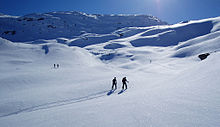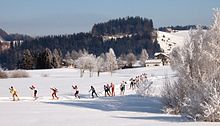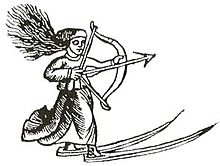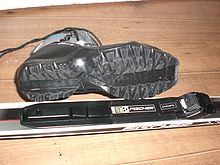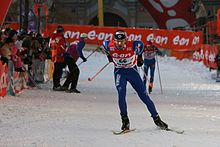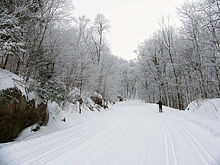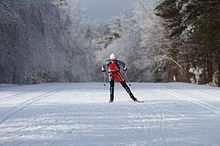- Cross-country skiing
-
Cross-country skiing 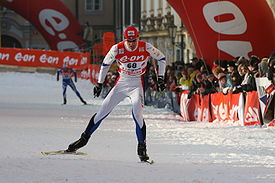
Priit Narusk in the qualification for the Tour de Ski in Prague.Nickname(s) XC skiing Characteristics Categorization Outdoor or indoor in ski tunnels Equipment Skis, poles and boots Olympic 1924 Cross-country skiing (commonly abbreviated XC skiing) is a winter sport in which participants propel themselves across snow-covered terrain using skis and poles. It is popular in many places with large snowfields, primarily Northern Europe, Canada, and Alaska.[1]
Cross-country skiing is part of the Nordic skiing sport family, which also includes ski jumping, and a combination sport of cross-country skiing and ski jumping called Nordic combined. Free-technique cross-country skiing is also the method of locomotion in the combination sport of Biathlon, which adds rifle marksmanship to skiing.[1] Another combination sport is ski-orienteering, which adds the skill of map navigation along snow trails and tracks.
Related sports are backcountry skiing and Telemark skiing. The ski touring article provides an overview of different ski styles and techniques.
Contents
Recreational skiing
Recreational cross-country skiing is most frequently known as touring. Some skiers stay out for extended periods using tents and equipment similar to bushwalkers/hikers, whereas others take relatively short trips from ski resorts on maintained trails. In some countries, organizations maintain a network of huts for use by cross-country skiers in wintertime. For example, the Norwegian Mountain Touring Association maintains over 400 huts stretching across hundreds of kilometres of trails which are used by hikers in the summer and by skiers in the winter.
Competition
As a sport, cross-country skiing is one of the most difficult endurance sports, as its motions use every major muscle group and it (along with running, rowing and swimming) is one of the sports that burn the most calories per hour in execution. One of the legends in cross-country skiing competitions is Bjørn Dæhlie (Norway). In a test performed by his physiologist, Erlend Hem, Dæhlie made a VO2-max of 96 ml/kg/min of O2, a world record.[2]
Modern cross-country ski competition is experiencing a revolution that is resulting in greater compatibility with audiences which began with the addition of the Sprint event to the World Cup and Olympic competitions in 2002. Today more and more races are being held in audience-friendly formats, such as mass start, sprint, relay and pursuit (a race that involves switching skis, and styles halfway through the race). The modern events in which athletes compete in at the World Cup and Olympics are (distances presented in Female/Male format): 1 km Sprint, 2X1 km Team Sprint, 10 km/15 km Individual Start, 15 km/30 km Pursuit, 30 km/50 km Mass Start, and 4x5 km/4x10 km Relay.
 Cesar Baena competes Cross-country skiing (classic style) in Liberec, Czech Republic during World Ski Championships 2009.
Cesar Baena competes Cross-country skiing (classic style) in Liberec, Czech Republic during World Ski Championships 2009.
Today, there are several types of cross-country competitive events, involving races of various types and lengths, as well as biathlon, involving a combination of cross-country skiing and target shooting with a rifle.
The Winter Olympics, the FIS Nordic World Ski Championships, and the FIS World Cup events (including the Holmenkollen) have long been a showcase for the world's fastest cross country skiers. There are also special distance ski races, sometimes called ski marathons, like Vasaloppet in Sweden, Birkebeineren in Norway, the Canadian Birkebeiner[3] the American Birkebeiner the Tour of Anchorage in Anchorage, Alaska and the Tug Hill Tourathon in the US. The skiing styles in these races might be fixed, or, in case of the so-called "double pursuit" event, the two styles are used each in their own separate half of the race (with a change of equipment in "pit stops" half way through).
The Canadian Ski Marathon, despite its name, is not a race, but a tour, the world's longest, at 160 km. The skiers choose their distance challenge and try to accomplish it. The highest honour, the Coureur de Bois Gold, is given to those who ski the entire distance and camp out overnight, bringing all their food and gear with them in a big backpack.
Since 2005, one of the world's longest cross country skiing races has been held in Forestville, Quebec, Canada. The Boreal Loppet has a race loop of 100 km.[4]
- Cross-country skiing at the Winter Olympics
- FIS Nordic skiing World Championships (including XC skiing)
- XC skiing World Cup (weekly races throughout the winter seasons)
History
Cross-country skiing originated in Fennoscandian countries in prehistoric times. It was still widely practiced in the 19th century as a way of moving from place to place in winter. Elk, deer and other animals were hunted by skiing. Nowadays many people in countries with strong cross-country skiing traditions — like Norway, Sweden, Finland, Estonia and Latvia — have used or regularly use skis.[1]
By contrast skiing is relatively new in North America and was introduced by Norwegian and Swedish immigrants in the 1850s. Snowshoe Thompson is widely credited for introducing the sport to California in the USA. In Canada pioneers included Aldolf Olsen, Sigurd and Hans Lockeberg and Jackrabbit Johannsen.[1]
In Canada, although Johannsen never claimed to be the first skier in Canada, he had a major role in stimulating an interest in the sport. He organized races, officiated events, and served as a guide, coach, and consultant for numerous skiing organizations, many of which he helped to found. An enthusiastic teacher, he helped coach Canada's Olympic team in 1932. At the age of 55, he shocked his Canadian Olympic pupils as he accompanied the team step by step through its rigorous training schedule—and still he had energy to spare. This was, however, still quite far from being the twilight of Jackrabbit's incredible skiing career, as he didn't ski his last official race until the age of 75, and still glided through the snowy woods on a daily basis well past the age of 100.[1]
This form of skiing has been used by explorers as a means of transport, and all Nordic armies have ski-trained infantry for winter operations. Skis gave important mobility to the Finnish army during the Winter War and allowed the small groups of Finns to beat large armies of Russians. Similar tactics that utilize skis have been used in many times by the Finns and Karelians in the past. Pre-modern skiing troops were armed with crossbows and ski poles which had a spearhead on the other end.
Traditionally, all of the equipment was made of natural materials: wooden skis and bamboo poles with leather hand straps.[5] Footwear was usually sturdy leather boots with thick soles. Bindings evolved from simple straps made of twisted wood-based thread, to the so-called Kandahar binding with the fastening of both the boot’s front and back, to the ‘Rat Trap’ front-only binding, which is today known as the Nordic norm, and has evolved in various modern bindings.[6]
Equipment
Equipment differs according to skiing technique.
Skis
The skis are long and narrow, to distribute the weight of the skier and allow the skier to move quickly. Typical ski dimensions are 2 metres in length, about 5 centimetres in width and one to four centimetres in thickness at different stations along the length of the ski. Depending on the ski design and purpose, they are fitted to the skier based on height and weight.[6] The toe of the skier's footwear is attached to the ski with a binding, while the heel remains free.[6]
Characteristics of cross-country skis:
- Width – Generally, a skating ski is shorter[7] and narrower[5] than a classic ski. A ski intended for off-track use is wider and heavier.[8] Cross-country skis are sometimes informally known as "skinny skis" because of their narrowness compared to alpine skis.[6]
- Tip – To help cut through deep snow, the tip of a cross-country ski is typically higher and more curved than an alpine ski.[citation needed]
- Camber – for classic technique, camber, the amount of vertical curvature in the ski, is crucial to create a kick zone.[7][8]
- Bottom surface – Many skis have smooth bottoms which require waxing, but waxless skis are available.[5][7]
- Edges – For track skiing, skis usually do not have metal edges; Backcountry and Telemark skis however often have edges.[5][7]
- Sidecut – indicates the shape or profile of the ski. Sidecut affects the way a ski tracks (travels in a straight line) and turns. Skis with limited sidecut and a straighter profile (Classic skis) track or glide forward easily. A ski with lots of sidecut will turn more easily but not track as smoothly. Skating skis usually have minimal sidecut: the tips and tails are only slightly wider than the waist. This increases stability in the glide phase.[7]
- Materials – Formerly, many skis were made of wood alone, or with a fiberglass or synthetic coating over the inner wood layer. Modern skis have synthetic foam cores.[5]
Poles
Like alpine skiing, cross-country skiers carry two poles for steadiness and propulsion. Early ski poles were usually made from bamboo, but this was supassed in the 1960s by aluminium or fiberglass construction. More expensive poles are made of graphite or carbon fiber or some other strong but lightweight material.[6]
Poles have a spike at the end to provide a fixed pivot when the pole penetrates through to a hard surface, and a plastic web or disc (called the basket), to provide extra purchase in snow and to ensure the pole doesn't sink too deeply. Different basket styles are available for different techniques and snow conditions.[5][9]
Nordic poles are longer than poles for alpine skiing. Skating or freestyle poles are usually longer than those used for the classic technique. Poles should be sized proportionally to the height of the skier. The wrist strap helps prevent the skier from dropping the pole, and also assists with pushing in all poling techniques.[9]
Bindings
The binding holds or clips the toe of the boot to the ski. Most bindings are mounted on the skis by screws.[6]
Depending on technique, boots are generally much lighter in construction than alpine boots. Boots for track skiing are lower cut, with less ankle support, resembling a running shoe. Skating boots are usually higher, stiffer, and reinforced around the heel and ankle. The increased stiffness is designed to support the lateral push-off of the skating stride. Backcountry boots are heavier, with more ankle support.[9]
Older styled three-pin bindings (Nordic Norm), with or without cables, are still used by backcountry and Telemarking enthusiasts.[6] The sole of the boot is extended forward slightly at the toe. There are three holes in the bottom of the toe which mate with the pins in the binding. With this system the sole of the boot flexes as the skier strides.
There are three primary groups of binding systems used in modern cross-country skiing:
- NNN (New Nordic Norm) – including R1-R3 and the new R4-R5 NIS (Nordic Integrated System) variants
- SNS (Salomon Nordic System) Profil
- SNS Pilot
Waxes
There are a wide variety of waxes for Nordic Skiing. The waxes can be classified into four main categories: glide waxes, kick waxes, klisters and waxtapes.[10]
Glide wax
Glide waxes are used to make a ski glide faster, and are applied by ironing onto the ski. Glide waxes range widely in price, depending on quality; racing waxes can be very expensive, over $100 for a 60 gram block of wax. They are generally in the form of blocks, though they can be found as powders or liquids. Glide waxes are applied outside the kick zone of classic skis, or to the full length of skate skis.[10] They are the only type of wax used on skating skis.[5] Typically, three different categories of wax may be used, depending on the level of cross country skiing. Hydrocarbon waxes, made from simple paraffin waxes, are used in most recreational and lower level glide waxing. Race waxing may use a combination of fluorinated hydrocarbon waxes and fluorocarbon overlays.[11] Fluorocarbons decrease surface tension and surface area of the water between the ski and the snow, increasing speed and glide of the ski under specific conditions. Either combined with the wax or applied after in a spray, powder, or block form, fluorocarbons significantly improve the glide of the ski and are widely used in cross country ski races.[12]
Kick wax
The purpose of kick wax is to provide grip on snow when weight is transferred on a ski; they are used on classic skis only. Kick waxes are applied in the kick zone of classic skis if the ski is not a fish-scale, waxless ski.[10][13]
Kick waxes are classified according to their hardness: harder waxes are for colder and newer snow. Using a wax that is too hard will not give sufficient grip, while wax that is too soft will cause the formation of an ice sole that slows the skier down. It is not uncommon to apply a new layer of wax if the weather changes, or when moving in altitude.[10]
The difficulty of choosing correct kick waxes to different conditions is nowadays greatly reduced by grip wax tapes, which have a wide temperature range, and are easily applied to the ski bottom. Although these are not used by competitors, who prefer the optimum waxing, they have proven to be quite suitable for fitness and recreational purposes. Many high-level competitive teams have "wax technicians" whose job is to apply the ideal wax combinations for the conditions.[citation needed]
Kick waxes generate grip by penetrating into the snowflakes when the skier puts his weight on the ski. Colder snowflakes are harder, and so is newly fallen snow. The most appropriate wax is the one that is soft enough to generate grip, but also hard enough not to accumulate snow and create a sole.[10]
Waxes are usually colour-coded by usage temperature: the most common are red for above 0˚C, and blue for below. There are many other colours for more specific temperature ranges, for instance violet for around 0˚C, green for below -10˚C, and white for below -15˚C. The snow-temperature range given by the producer must be taken with a grain of salt, since new snow will require a harder wax.[10]
Guessing the right hardness can be quite difficult, and the varying condition of the snow can make the right choice wrong after a few hundred metres. Furthermore, the snow in the beaten track is usually much different from the one immediately surrounding it, and works best with a softer wax. If skis are poorly tuned, sometimes the skier can solve thin snow soles caused by a soft wax by beating the ski on the track after kicking; the opposite problem may be handled by skating. One way around the problems of standard grip wax is to use a wax grip tape, which is applied to the kick zone of the ski in tape form. The tape can last for 100 to 200 km (62 to 124 mi) has a very wide temp range (-20C to +5C), and can be left on the ski at the end of the day and stored by covering in waxed paper.[10]
Klister
If the temperature is above zero in Celsius scale, kick wax cannot provide any more grip. One must therefore resort to klister, which is basically a glue-like paste (in Scandinavian languages "klister" actually means "paste", "glue" or "size" used in papering). Klister is discouraging for amateurs, as it is very sticky, it is easy to apply but very difficult to remove.[10]
Klister can be applied with a plastic blade or with the palm of the hand. The hand is then cleaned in the glove, rubbing against the glove fabric while sweating. Since klister is a non-polar substance, a non-polar solvent (such as mineral spirits) or a soap is necessary to remove it. It is possible to buy solvents made specifically for cleaning skis. These should be used with care, as they are both flammable and toxic if inhaled or absorbed through the skin.[10]
Klister is also colour-coded: red, purple, blue and silver.[10]
Waxless skis
In recent decades waxless skis have become popular in the recreational ski market. Introduced in 1970, waxless skis accounted for 75 percent of cross country sales in the United States in 1985, despite their typically poor performance compared with well-waxed skis.[14]
Waxless skis have a fish scale, cross-hatched or ridged pattern in the kick zone to provide grip. A waxless ski is inferior to a finely tuned waxed ski, but does not require the sometimes time-consuming and sometimes costly selection and application of kick wax or klister and will work between temperatures, an important advantage in areas with many sun/shadow boundaries. Some skiers apply a layer of glide wax to keep them sliding smoothly and protecting the surface from dirt and ice build-up. There are specialty liquid wax products on the market manufactured for waxless skis, though standard glide wax can also be used on the tips and tails of the ski.[6][15][16]
Waxless skis are better suited to recreational and casual skiers who want to ski with minimal time spent on maintenance, as they generally produce too much drag for competitive skiers and those who value comparatively effortless movement.[6][17]
Waxless skis are sometimes used by Nordic racers during variable ski conditions such as temperatures over freezing. At the 1976 Winter Olympics held in Innsbruck, US ski team member Bill Koch won a silver medal on waxless skis.[14]
Styles and techniques
There are three main styles used in cross-country skiing: classic, skating and telemarking. There is also skiathlon, which combines classic and skating. Specially adapted equipment is available to suit each. Another style growing in popularity is skijoring. In skijoring, the skier is pulled over the snow by one or more dogs, or, alternatively, a snowmobile. Both classic and skating techniques are used by skijorers.
 Opening a track through deep snow can be quite arduous.
Opening a track through deep snow can be quite arduous.
Classic
The classic style is often used on prepared trails (pistes) that have pairs of parallel grooves (tracks) cut into the snow.
Skis have camber and should leave the centre section of the ski clear of the snow when the skier's weight is evenly distributed between the pair. The centre section of a classic ski will either have "fish scales", or ski wax that will stick to the snow (called the "kick zone" or "grip zone" of the ski). When full weight is transferred to a single ski the kick zone comes into contact with the snow.[8] Glide wax is used on the tails and tips of the skis.[5]
The basic techniques of classic skiing are classified by flat terrain, uphill, downhill and turning. On the flat terrain the diagonal stride is most commonly used and is a running action with parallel skis, kicking and gliding with each stride. The poles are planted alternately on the opposite side to the kick. Three-step and four-step diagonals are also used. The three-step is also known as a change-up or passgang and involved three strides to one pole push. Another flat-terrain technique is double poling, whereby the legs are not moved and all propulsive force is provided by the two poles used together. Double poling may be combined with strides in the one-step and two-step double pole techniques.[18]
On uphill terrain classic techniques include the side step where the skis are used perpendicular to the slope, the herringbone, where the skis are "V"ed outwards and a tight diagonal, where the flat land diagonal technique is employed with much shorter glides.[18]
Downhill classic skiing involves using the snowplow, whereby the skis are turned inwards with the tips nearly together to create drag and thus descent speed. Turning on flat terrain is often accomplished with a tip-turn, moving the skis round the turn from a diagonal stride. Another turning technique is the kick-turn, conducted by lifting the ski while double poling. The skate-turn transfers the weight onto the turning forward ski as in ice skating. Other methods of turning include the telemark-turn, using the trailing ski as a rudder, skid-turn and stem christie alpine-turn done from a downhill snowplow.[18]
Skate skiing
Cross-country ski trails at Gatineau Park, Quebec, track-set for classic skiing at the sides and groomed for skate skiing in the centre.
Skate skiing involves a decisive weight transfer onto one ski angled and then the other, supported by the inner edge of the ski on the snow, which looks similar to an ice skater. As in classic skiing, transferring weight completely from one ski to the next is essential to learning to skate. Those who have learned to ice skate or rollerskiing may find ski skating technique easier to learn than classic skiing. The free technique in XC skiing is not to be confused with freestyle, which describes ski sport where the competitors compete over a mogul course and by performing aerial gymnastics such as spins after launching from a short ramp in the snow.[citation needed]
Skate skiing can be done either with skis specifically designed for skating or 'combi' skis for both skating and classic styles. Similarly, specialized skating boots or combi boots can be used. Skate skis tend to be shorter and stiffer than those used for the classical technique, and the poles are longer. Neither fish scale skis nor grip wax are used.[citation needed]
Different limb-movement patterns are used for different terrain and speeds. There is no internationally accepted naming convention for these techniques.
Names Description Gear 1 Similar to the classic herringbone but with a short glide on each ski. This technique is used in racing only on very steep hills. As the name indicates it is often used by weaker skiers, both in training and racing.[19] diagonal V single-poling coach's skate granny skate Gear 2 Slightly off-set double-pole on every other leg. Used mostly for hill climbing in competitions.[citation needed] V1 Offset skate Gear 3 Double-pole on every leg. Used on the flat for accelerating and on moderate uphills. Requires a good balance. Essential for any serious competitor but often not used nor mastered by hobbyists.[citation needed] V2 1-skate Wassberg Gear 4 Double-pole on every other leg. Used on the flat, while climbing and on gentle downhills.[citation needed] V2 alternate Open field skate 2-Skate Mogren Gear 5 Skating without using the poles. Used exclusively on downhills at very high speed.[citation needed] V skating Free-skate There are also variants of these techniques, most notably hop-skating, which involves dynamic tempo causing both skis to leave the snow at the same time; generally it is used as a V-1 (offset skate) variant on short hills, but a few racers jump-skate in V-2 (1-skate) sprinting.
Skating style became popular during 1980s. The Finnish skier Pauli Siitonen used the style in 1970s (in Germany in the 1980s skating was called "Siitonen-Schritt" in reference to him). Siitonen had found the style useful at the middle of the race he already thought was lost. After switching to skating Siitonen managed to win the race, to his surprise. The success of Bill Koch (USA) in 1982 Cross-country Skiing Championships held in Oslo drew more attention to the skating style. In the 1984 Winter Olympics of Sarajevo many competitors used an immature form of skating kicking extra speed with one feet (trail being in the middle of trace matured technique was not appropriate). This trend was yet stronger at Seefield's World Championships in 1985. The International Ski Federation (FIS) was confused about these developments. At Seefeld there were some attempts to force competitors to use the traditional style by using plastic walls during the 30 km race. However, later that year the FIS decided to start organising separate races for traditional and skating styles. Separate traditional and free events were used already in World Championships held in Oberstdorf (1987).[citation needed]
Skating technique is only suitable for use on prepared trails (pistes), firm and smooth snow or snow crust and frozen snow-covered lakes or rivers.[citation needed]
Skating is faster and different muscular exercise than classic skiing, except in extremely cold conditions where classic skiing may approach skating in speed. Adoption of the skating technique varies from country to country. In some countries the majority of non-professional racers now skate, although top skiers continue to learn and train in both styles.[citation needed]
The distinction between classic technique and free technique is made in competition i.e., a race will be designated as classic or free. In the case of the former only those propulsion techniques that are considered 'classic' are allowed whereas in the latter the competitors are free to use any technique although the majority of competitors will opt to skate. Large races will often have both skate and classic divisions and award prizes in both categories.[citation needed]
Recent developments in the sport include "double pursuit" races where the competitors complete the first part of the event using the classic technique and the second part using the free technique.[citation needed]
See also
- Grass skiing
- Hazards of outdoor activities
- International Association of Worldloppet Skiers
- Monoskiing
- Nordic Skiing
- Pursuit racing
- Roller skiing
- Snowboarding
References
- ^ a b c d e Rees, 1981, pages 3-9
- ^ www.traininglog.dk/XC (2009). "Bjoern Daehlie (born June 19, 1967)". http://www.traininglog.dk/daehlie.html. Retrieved 2009-09-13.
- ^ Canadian Birkebeiner Society (2007). "The Birkebeiner Legend". Archived from the original on 2008-02-06. http://web.archive.org/web/20080206132000/http://www.canadianbirkie.com/about.php. Retrieved 2008-02-27.
- ^ Boreal Loppet (February 2008). "Boreal Loppet". Archived from the original on 2008-01-23. http://web.archive.org/web/20080123082859/http://www.boreal100kloppet.ca/main.php?lang=en. Retrieved 2008-02-27.
- ^ a b c d e f g h CrossCountryCanada Overview
- ^ a b c d e f g h i Rees, 1981, pages 11-45
- ^ a b c d e MEC website Cross-country skis
- ^ a b c XCSkiworld Classic Equipment
- ^ a b c MEC website Nordic Ski Boots, Bindings, & Poles
- ^ a b c d e f g h i j Rees, 1981, pages 81-99
- ^ Information on Fluorinated Waxes, http://www.nordicskiracer.com/news.asp?NewsID=5429
- ^ Fluorocarbons waxes are a skier’s best friend, Swix, 22 February 2011
- ^ SkiWax.ca
- ^ a b Inventing a ski that you didn't have to wax was easy. Listening to everybody laugh was the hard part
- ^ Bergin, Ron (2008). "Back to Basics: A Quick Look at Paste Waxes, Waxless Ski Preparation and Kick Waxing". Archived from the original on 2007-04-02. http://web.archive.org/web/20070402051820/http://www.snocountry.com/article.php/20041227133240622. Retrieved 2009-01-25.
- ^ XC Ski World (undated). "Equipment - For Classic". http://www.xcskiworld.com/equip/equip_classic.htm. Retrieved 9 May 2010.
- ^ Mountain Equipment Coop (2010). "Cross-Country Skis (Nordic Skis)". http://www.mec.ca/Main/content_text.jsp?FOLDER%3C%3Efolder_id=2534374302887206&CONTENT%3C%3Ecnt_id=10134198674018167&bmUID=1273406691921. Retrieved 9 May 2010.
- ^ a b c Rees, 1981, pages 46-79.
- ^ Single-Poling Skate
Bibliography
- Rees, David: Cross Country Skiing - Third Edition, Copp Clark Pitman, Toronto, 1981. ISBN 0-7730-4045-5
External links
- FIS-Ski.com - The Governing Body for Cross Country Ski Racing worldwide
- U.S. Ski and Snowboard Association - The Governing Body for Cross Country Ski Racing in the United States
Videos
- Video of World Cup Skiers demonstrating diagonal stride technique
- Video of World Cup Skiers demonstrating offset / V1 technique
- Video of World Cup Skiers demonstrating double poling technique
- Video of World Cup Skiers demonstrating step double poling technique
- Video of World Cup Skiers demonstrating One Skate / V2 technique
- Video of World Cup Skiers demonstrating Two Skate / V2 alternate technique
Olympic sports Summer sports Archery • Athletics • Badminton • Basketball • Boxing • Canoeing • Cycling • Diving • Equestrian • Field hockey • Fencing • Football • Gymnastics • Handball • Judo • Modern pentathlon • Rowing • Sailing • Shooting • Swimming • Synchronized swimming • Table tennis • Taekwondo • Tennis • Triathlon • Volleyball • Water polo • Weightlifting • Greco-Roman Wrestling
Winter sports Alpine skiing • Biathlon • Bobsleigh • Cross-country skiing • Curling • Figure skating • Freestyle skiing • Ice hockey • Luge • Nordic combined • Short track speed skating • Skeleton • Ski jumping • Snowboarding • Speed skating
Former Olympic sports Baseball • Basque pelota • Cricket • Croquet • Golf • Jeu de paume • Lacrosse • Polo • Rackets • Roque • Rugby union • Softball • Tug of war • Water motorsports
Part of the 2016 program Human-powered transport Land Pedal powerBicycle · Bicycle trailer · Cycle rickshaw · Freight bicycle · Mountain bike · Party Bike · Quadracycle · Recumbent bicycle · Road bike · Tandem bicycle · Trailer bike · Tricycle · Trikke · Unicycle · Velocar · Velocipede · VelomobileHand-powerRow-actionRowing cyclesFoot powerPushed/pulledBaby transport · Baggage cart · Gurney · Handcart · Hand truck · Pulled rickshaw · Shopping cart · Stairclimber · WheelbarrowCarriedWater Snow and ice Alpine touring skis · Crampons · Cross-country skis · Ice skates · Kicksled · Snowshoes · Telemark skis · Snowboard · SledAir Categories:- Skiing competitions
- Cross-country skiing
- Olympic sports
- Types of skiing
Wikimedia Foundation. 2010.

